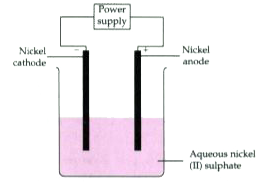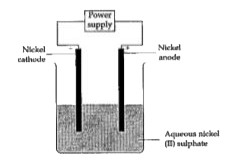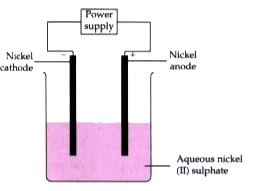The solution of nickel sulphate in which nickel rod is dipped is diluted 10 times. The halfcell potential of nickel:
Decreases by 60 mV
Increases by 30 m V
Decreases by 30 m V
Decreases by 60 V
The correct Answer is:C
To solve the problem of finding the half-cell potential of a nickel electrode when the nickel sulfate solution is diluted 10 times, we will use the Nernst equation. Here’s a step-by-step breakdown of the solution:
Step 1: Understand the Nernst Equation
The Nernst equation relates the cell potential (E) to the standard electrode potential (E°) and the concentrations of the reactants and products. The equation is given by:
E=E°−0.059nlog(oxidized form)(reduced form)
For nickel, the half-reaction can be represented as:
Ni2++2e−↔Ni
Here, n=2 because 2 electrons are involved in the reduction of nickel ions.
Step 2: Set Up the Initial Conditions
Let’s denote the initial concentration of nickel ions in the solution as (Ni2+)0. After diluting the solution 10 times, the new concentration of nickel ions will be:
(Ni2+)=(Ni2+)010
Step 3: Apply the Nernst Equation Before and After Dilution
1. Before Dilution:
E1=E°−0.0592log(Ni2+)0
2. After Dilution:
E2=E°−0.0592log((Ni2+)010)
Step 4: Simplify the Expression for After Dilution
Using the properties of logarithms, we can rewrite the second equation:
E2=E°−0.0592(log(Ni2+)0−log10)
E2=E°−0.0592log(Ni2+)0+0.0592⋅1
E2=E1+0.0592⋅1
Step 5: Calculate the Change in Potential
The change in potential due to dilution is:
E2−E1=0.0592=0.0295Vor29.5mV
Step 6: Determine the Final Potential
Thus, the potential of the nickel electrode after dilution increases by approximately 30 mV:
E2=E1+0.03V
Conclusion
The half-cell potential of the nickel electrode increases by about 30 mV after the solution is diluted 10 times.
The Nernst equation relates the cell potential (E) to the standard electrode potential (E°) and the concentrations of the reactants and products. The equation is given by:
Let’s denote the initial concentration of nickel ions in the solution as (Ni2+)0. After diluting the solution 10 times, the new concentration of nickel ions will be:
1. Before Dilution:
E1=E°−0.0592log(Ni2+)0
E2=E°−0.0592log((Ni2+)010)
Using the properties of logarithms, we can rewrite the second equation:
E2=E°−0.0592log(Ni2+)0+0.0592⋅1
E2=E1+0.0592⋅1
The change in potential due to dilution is:
Thus, the potential of the nickel electrode after dilution increases by approximately 30 mV:
The half-cell potential of the nickel electrode increases by about 30 mV after the solution is diluted 10 times.
Topper's Solved these Questions
- ELECTROCHEMISTRYBOOK - VMC MODULES ENGLISHCHAPTER - ELECTROCHEMISTRYEXERCISE - ENABLE
50 Videos
- ELECTROCHEMISTRYBOOK - VMC MODULES ENGLISHCHAPTER - ELECTROCHEMISTRYEXERCISE - EFFICIENT
46 Videos
- ELECTROCHEMISTRYBOOK - VMC MODULES ENGLISHCHAPTER - ELECTROCHEMISTRYEXERCISE - JEE Advanced (Archive)
76 Videos
- CLASSIFICATION OF ELEMENTS AND PERIODICITY IN PROPERTIES BOOK - VMC MODULES ENGLISHCHAPTER - CLASSIFICATION OF ELEMENTS AND PERIODICITY IN PROPERTIES EXERCISE - JEE ADVANCE (ARCHIVE)
30 Videos
- ENVIRONMENTAL CHEMISTRYBOOK - VMC MODULES ENGLISHCHAPTER - ENVIRONMENTAL CHEMISTRYEXERCISE - JEE Main (Archive)
39 Videos
Similar Questions
Knowledge Check
Aqueous solution of nickel sulphate on treating with pyridine and then adding a solution of sodium nitrite gives dark blue crystals of
A[Ni(py)4]SO4B[Ni(py)2(NO2)2]C[Ni(py)4](NO2)2D[Ni(py)3(NO2)]2SO4An aqueous solution of nickel (II) sulphate was electrolyzed using nickel electrodes. Observe the diagram and answer the questions that follow

Which equation for the reaction at the anode is correct ?ANi→Ni2++2e−BNi+2e−→Ni2+CNi2+→Ni+2e−DNi2++2e−→NiAn aqueous solution of nickel (II) sulphate was electrolysed using nickel electrodes. Observe the diagram and answer the questions that follow :

Which equation for the reaction at the anode is correct?ANi→Ni2++2e−BNi+2e−→Ni2+CNi2+→Ni+2e−DNi2++2e−→Ni
Nickel is component of
View SolutionGive one physiological role of nickel.
View SolutionAqueous solution of nickel sulphate on treating with pyridine and then adding a solution of sodium nitrite gives dark blue crystals of :
View SolutionThe same current was passed successively through the solutions of zinc sulfate and nickel ammonium sulfate (rendered alkaline with ammonia). The weights of zinc and nickel deposited in a certain time were found to be 0.531 and 0.477 g. respectively. Given that the equivalent weight of zinc is 32.7, calculate that of nickel.
View SolutionAn aqueous solution of nickel (II) sulphate was electrolyzed using nickel electrodes. Observe the diagram and answer the questions that follow

Name the cation that remains as a spectator ion in the solution.
View Solution

